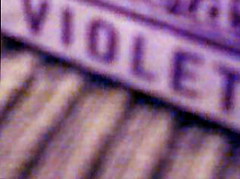Imani Henry. B4T. Highways Performance Space. 2/9/06.
I'm glad Imani Henry is telling his story. B4T is an interesting and valuable look at the pains and difficulties of three "Black, masculine, female-bodied people." These are stories that need to be told, and I am very much glad that I heard them. Henry is a talented performer, doing a fairly good job at establishing separation between 3 similar characters and doing an excellent job at keeping the audience engaged throughout. He talks skillfully at the intersections of race, class, gender and sexuality, and those positions and perspectives are important.
What bothered me about this piece, however, was its conceptualization of transition. B4T didn't seem particularly intended to educate the viewer about transition in any way, which is fine, but it consistently depicted testosterone or medical transition as a violent rupture in the speakers' lives, and I'm not entirely comfortable with that. For LaShawnda, the most visibly female-bodied of the three characters, the decision to transition was configured to suggest suicide. For Keith, who seems to be post-transition but reminiscing, he discusses how he could never go back, couldn't or wouldn't go to a high school reunion or see the friends who knew him to be a girl however much he was one of the guys. For Imani, the violence is in his inability to explain an impending transition to his dying grandmother, the enforced silence that comes from a not entirely accepting family.
The other thing that bothered me about the piece was its profound rejection of the term 'lesbian.' While it's perfectly understandable that these characters who don't consider themselves women might have problems with being labeled 'lesbian,' the revulsion for the term wasn't carefully teased out in this piece. Keith's absent interviewer, placed in a strange position of authority by her absence and seemingly elevated posiiton, was apparently a lesbian and Keith asked her 'why can't you tell your own stories,' creating and exacerbating a distance between himself as subject and the interveiwer as academic, lesbian, and seeminly priviledged. There was an extremely difficult moment, almost unexplored, in which Keith said that his girlfriend of 10 years was a lesbian, and it was profoundly unclear about whether that meant that she still identifies as lesbian or just that she did when they met. And either way, how does he feel about that? How does she feel about that? These absent female partners were pushed into an extemely awkward erasure throughout the piece in that both Kieth and Imani acknowledged girlfriends, but failed to represent them or even talk about them coherently Similarly, the butch and FTM person of color slide show that bridged the gap of a costume change featured several photos in which the subjects were kissing girlfriends, but those girlfriends were similarly unrecognized.
The success of B4T is in performing 3 different characters telling their stories in relationship to race, gender, and identity. The failure was in showing why and how these were three different characters. Why and how weren't they 3 aspects of Imani telling his own story? Would it have been more powerful speaking from a place of explicit identity rather than semi-autobiographical fiction? I would have liked to see more about where and why these characters divereged and conflicted. Why and how were each of them before T? I found myself wondering how long Henry had been performing this piece. How distant is the moment before T? How has this piece changed as his body has changed? Why not tell a story after T? B4T is a step in the right direction in terms of making more explorations of identity available and raising issues related to gender and sexuality. There are a lot more steps out there, and I'm excited to see them all.
Purple Rain
-
I went to Minneapolis to check out the stage version of *Purple Rai*n.
There were many issues but the one that sticks in my craw a month after
seeing the...
4 days ago

0 comments:
Post a Comment